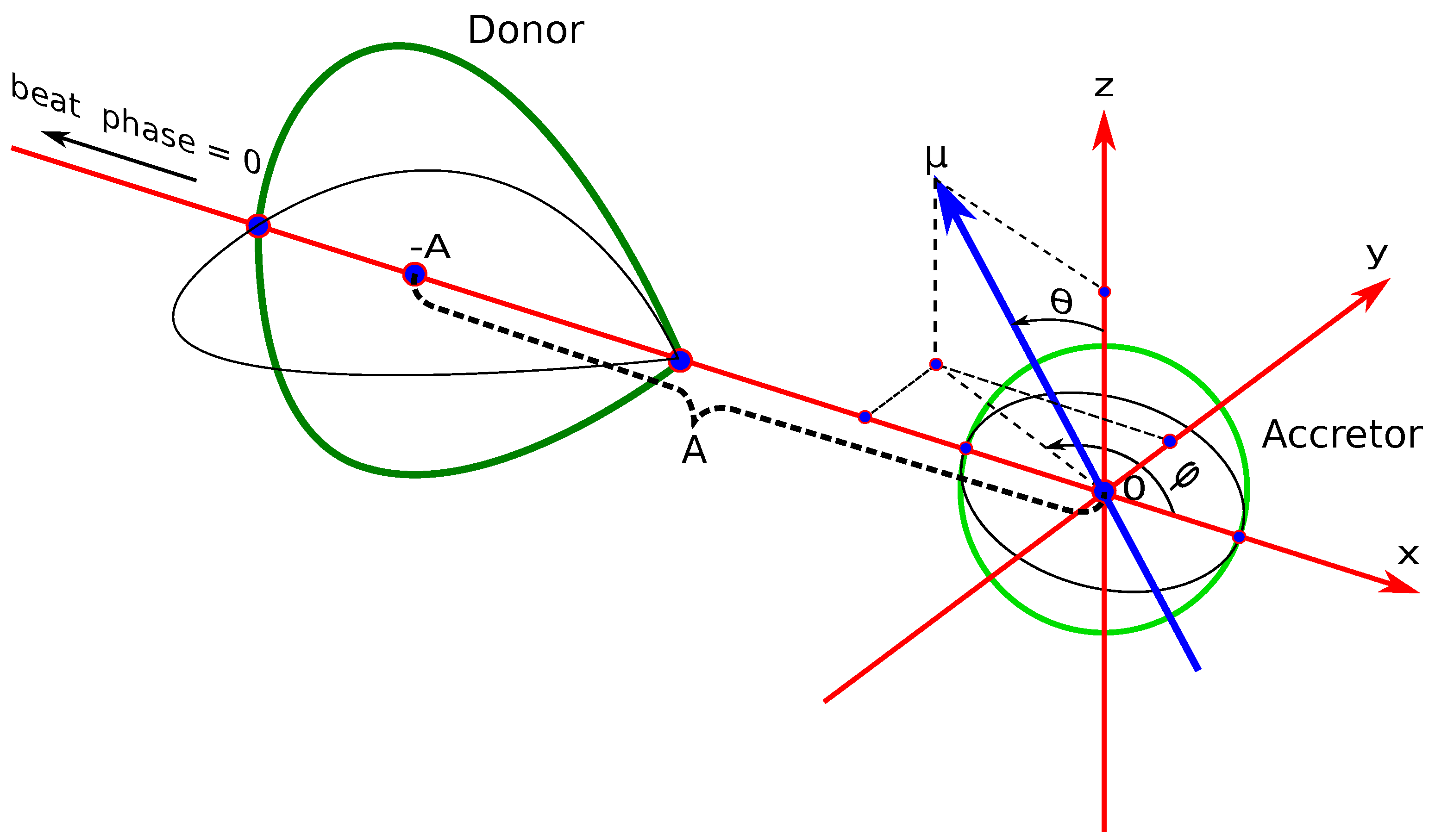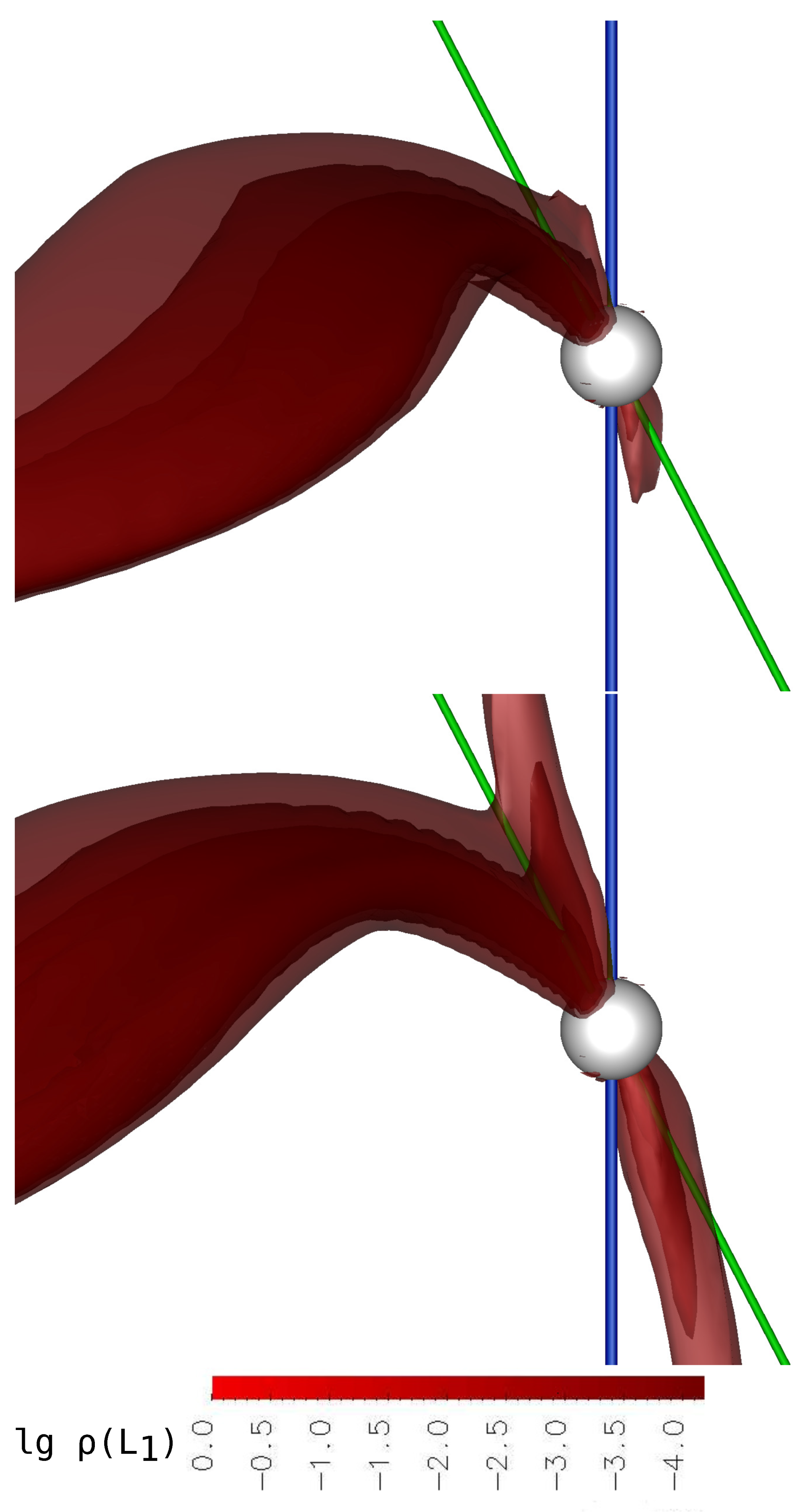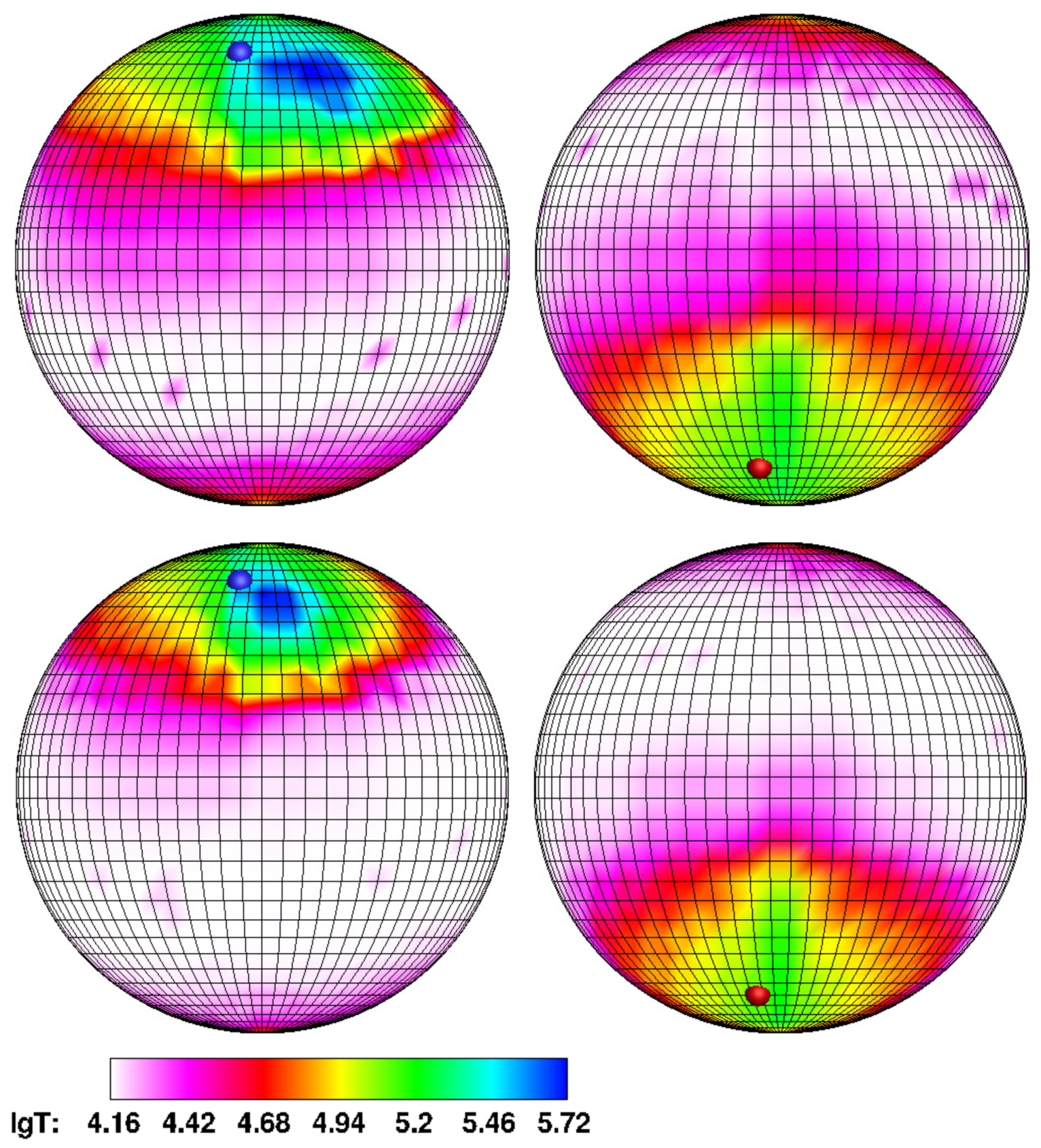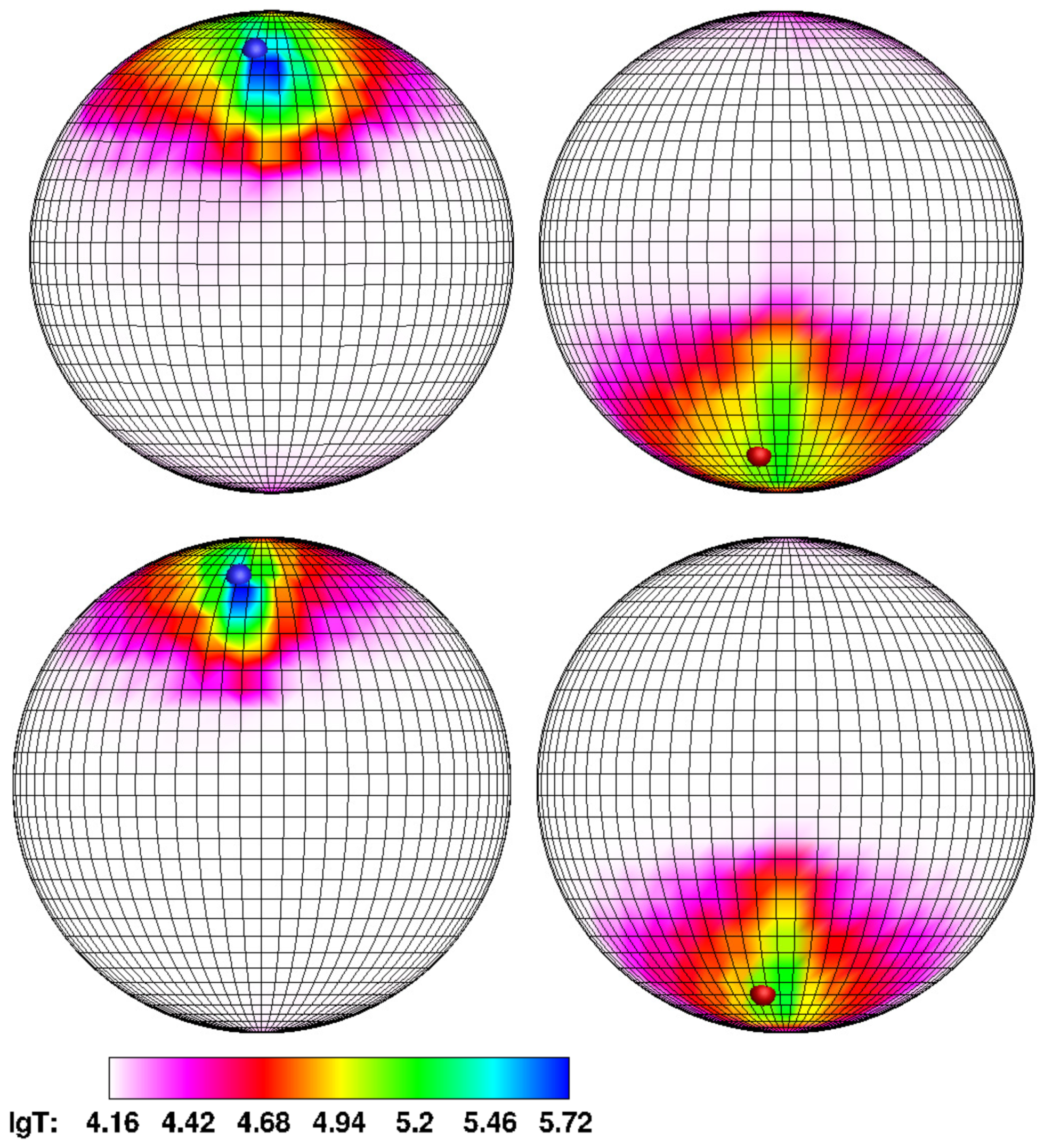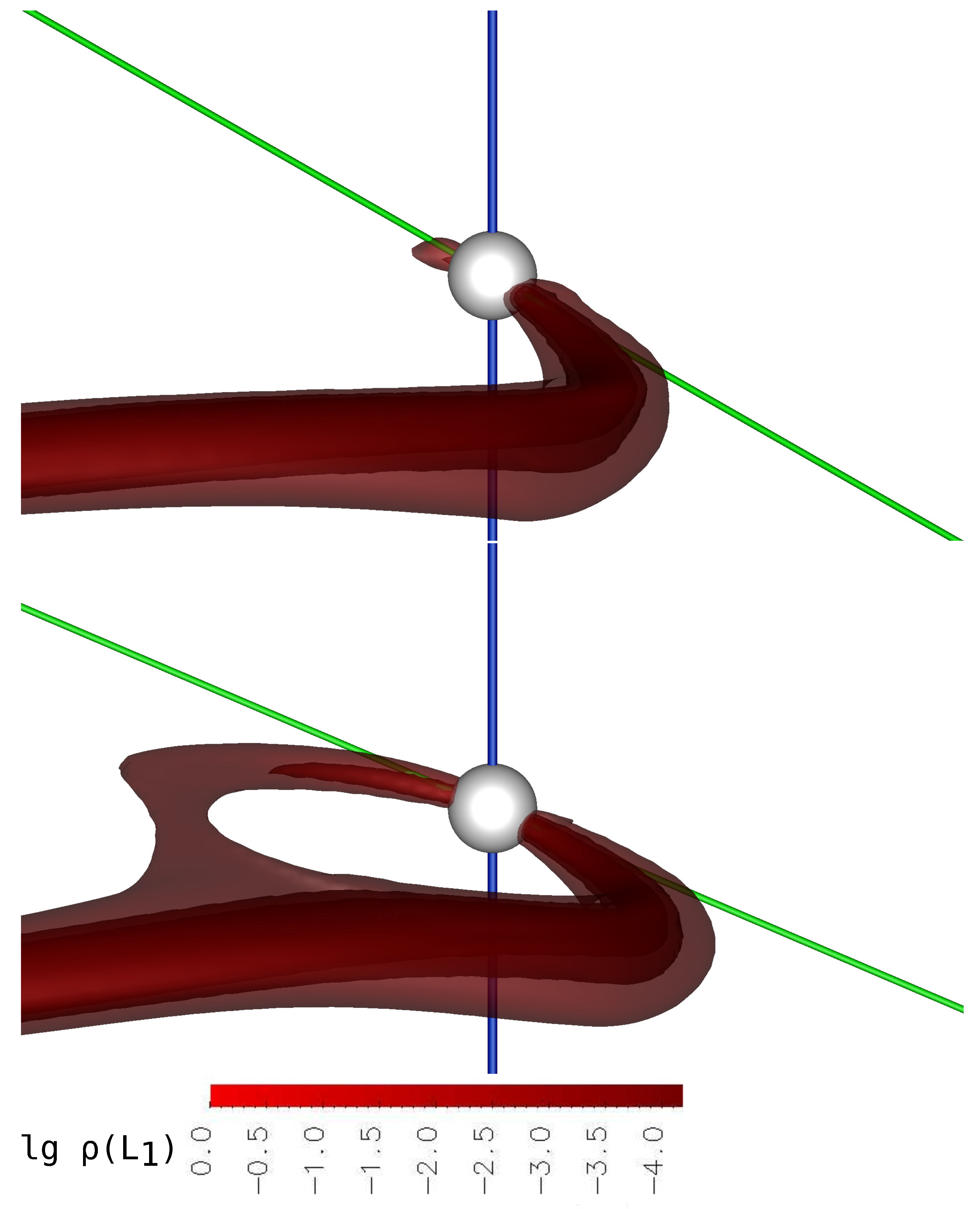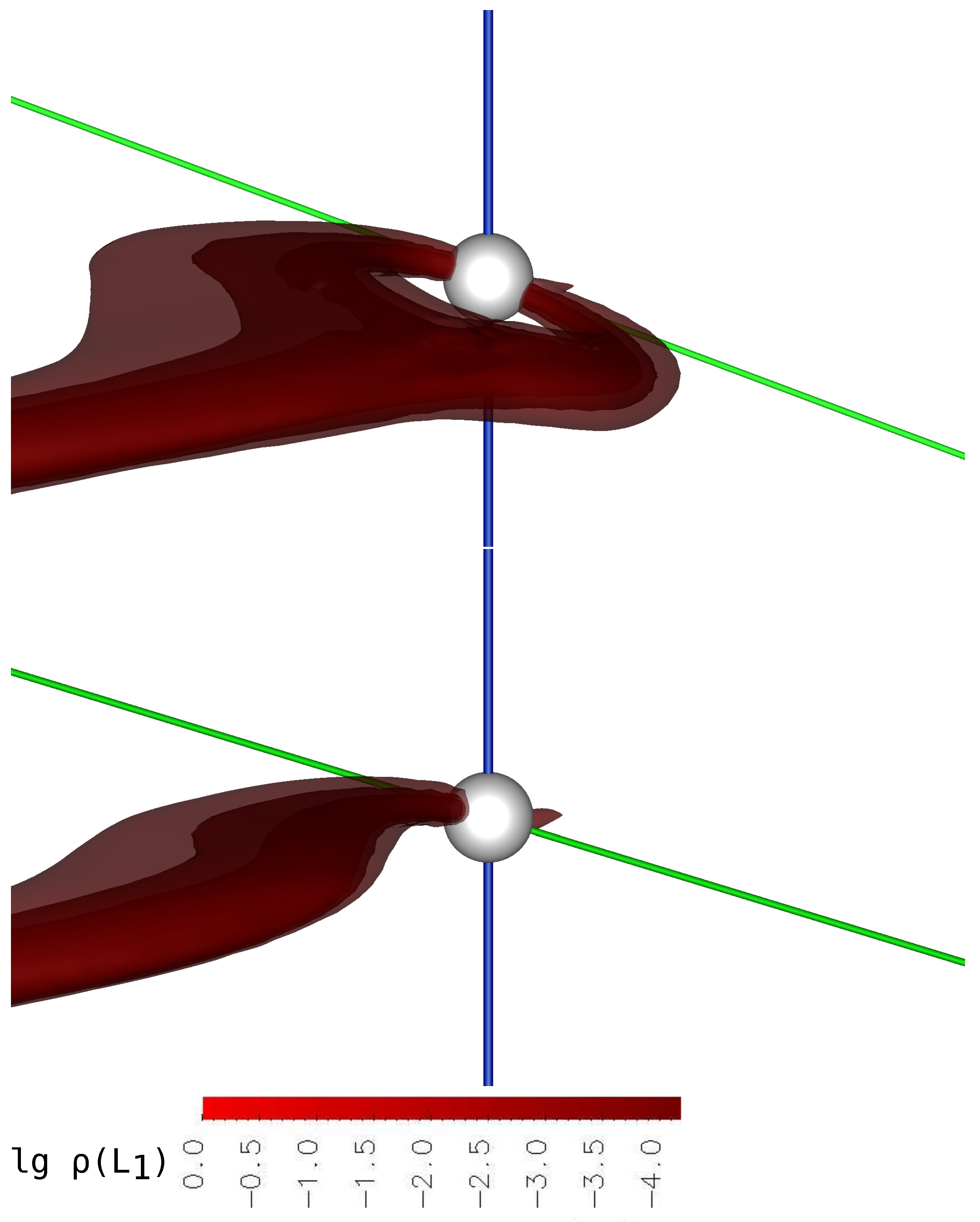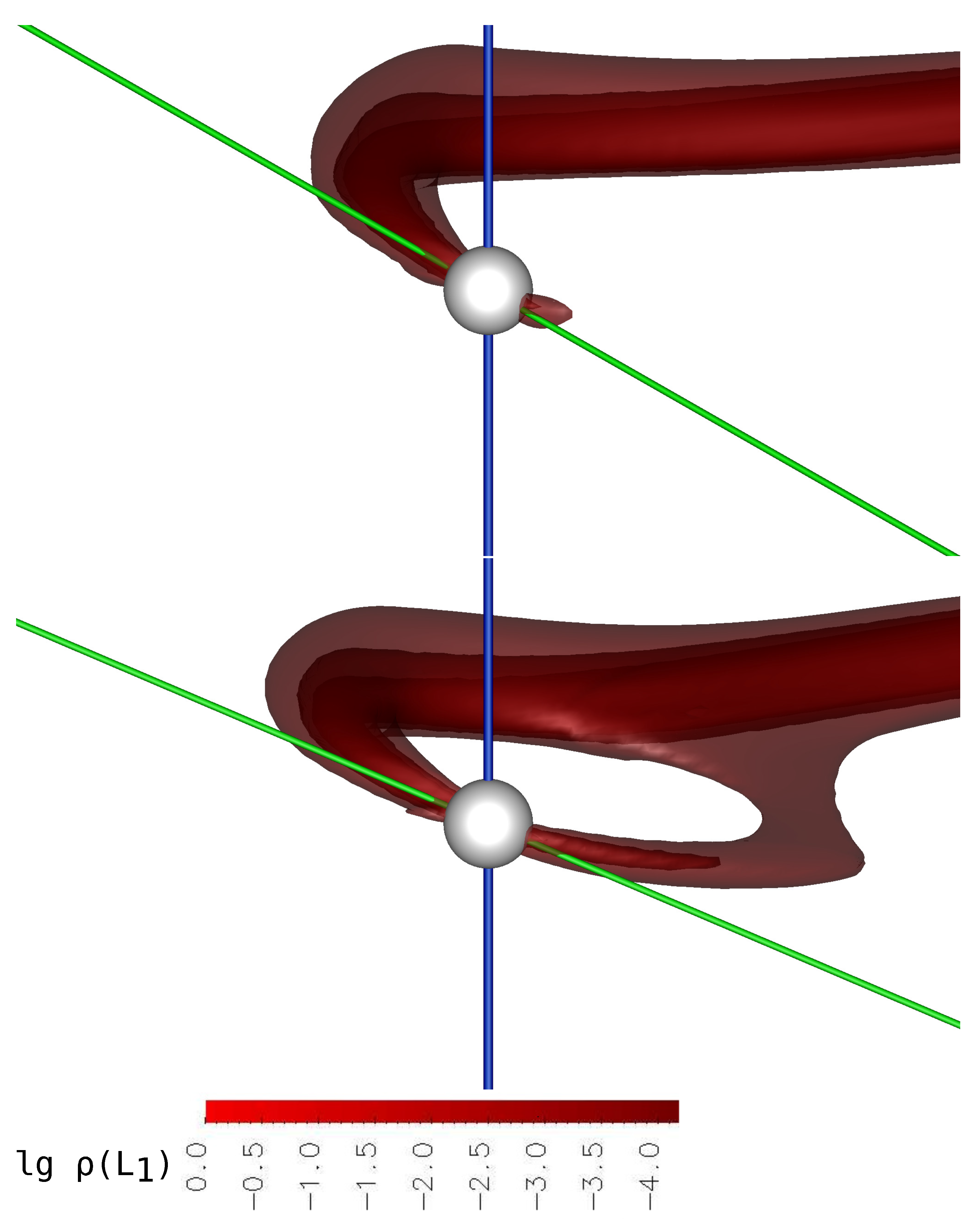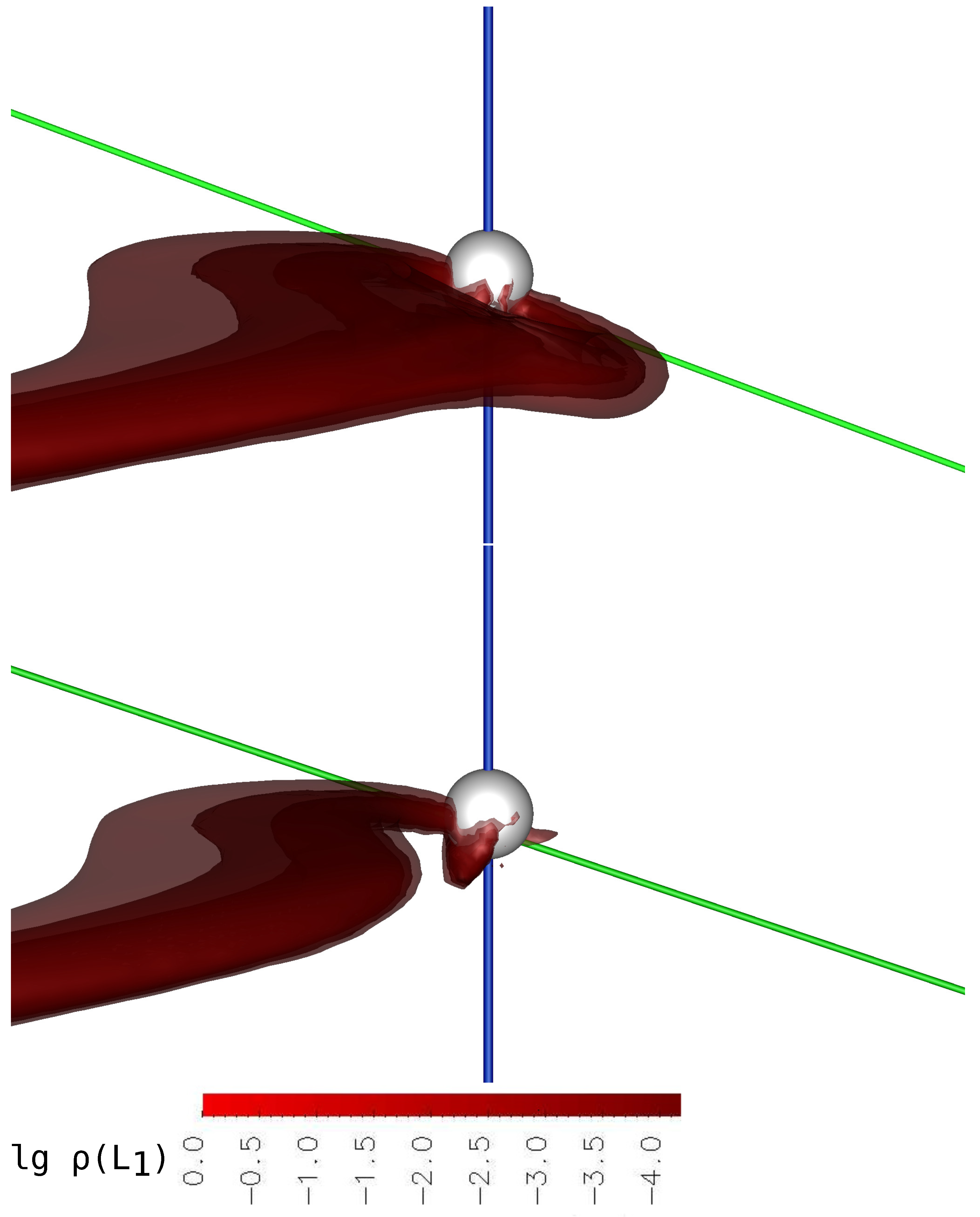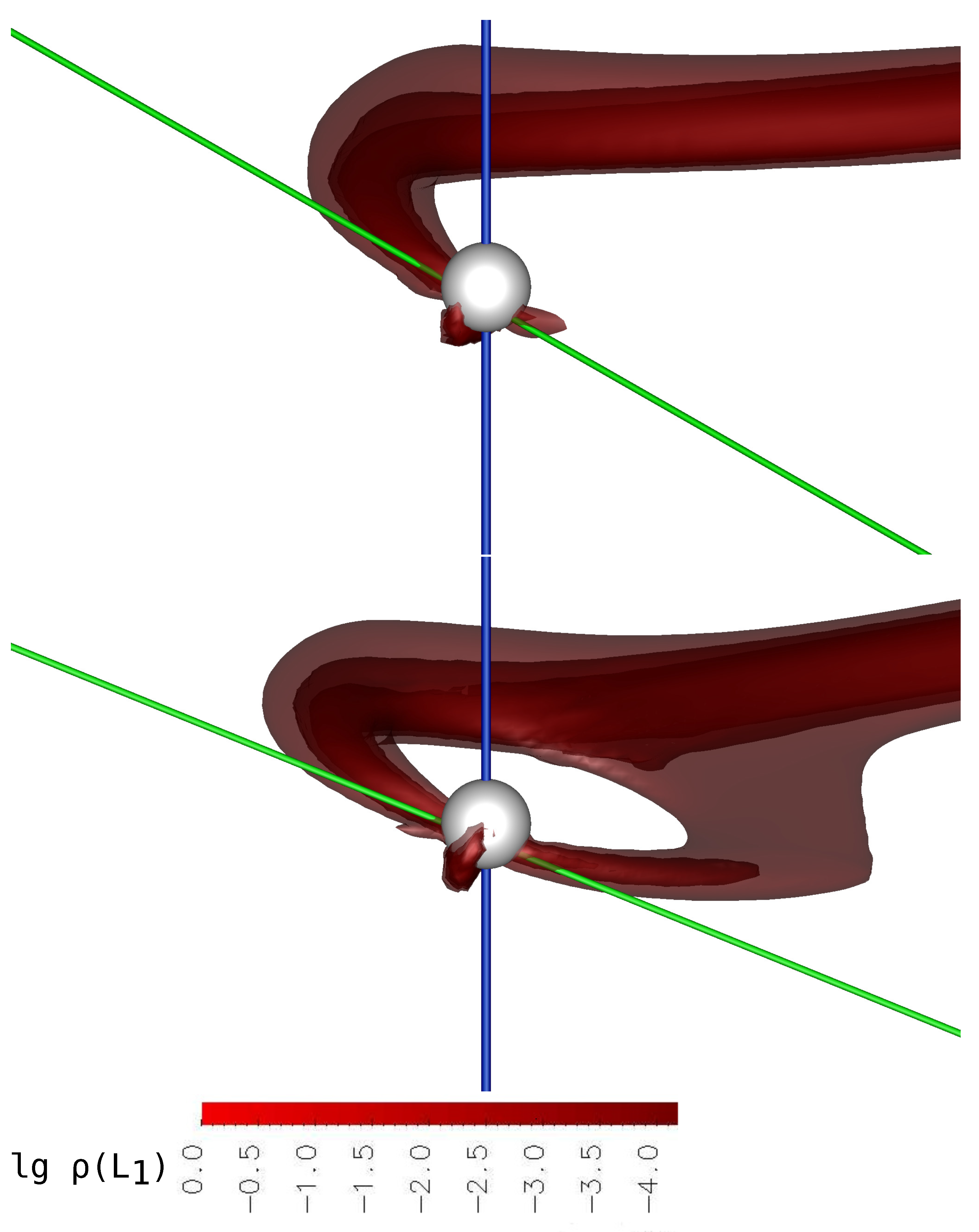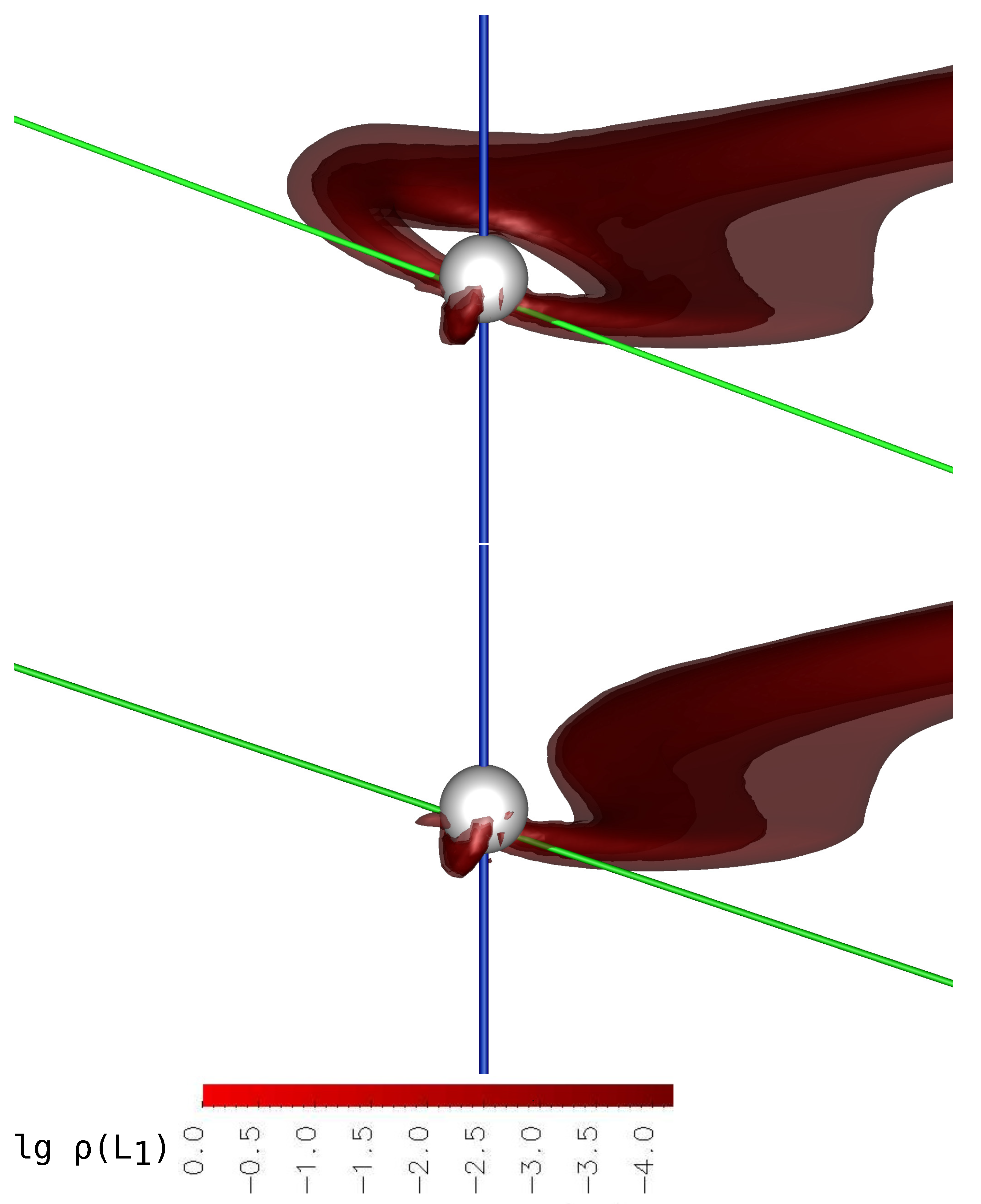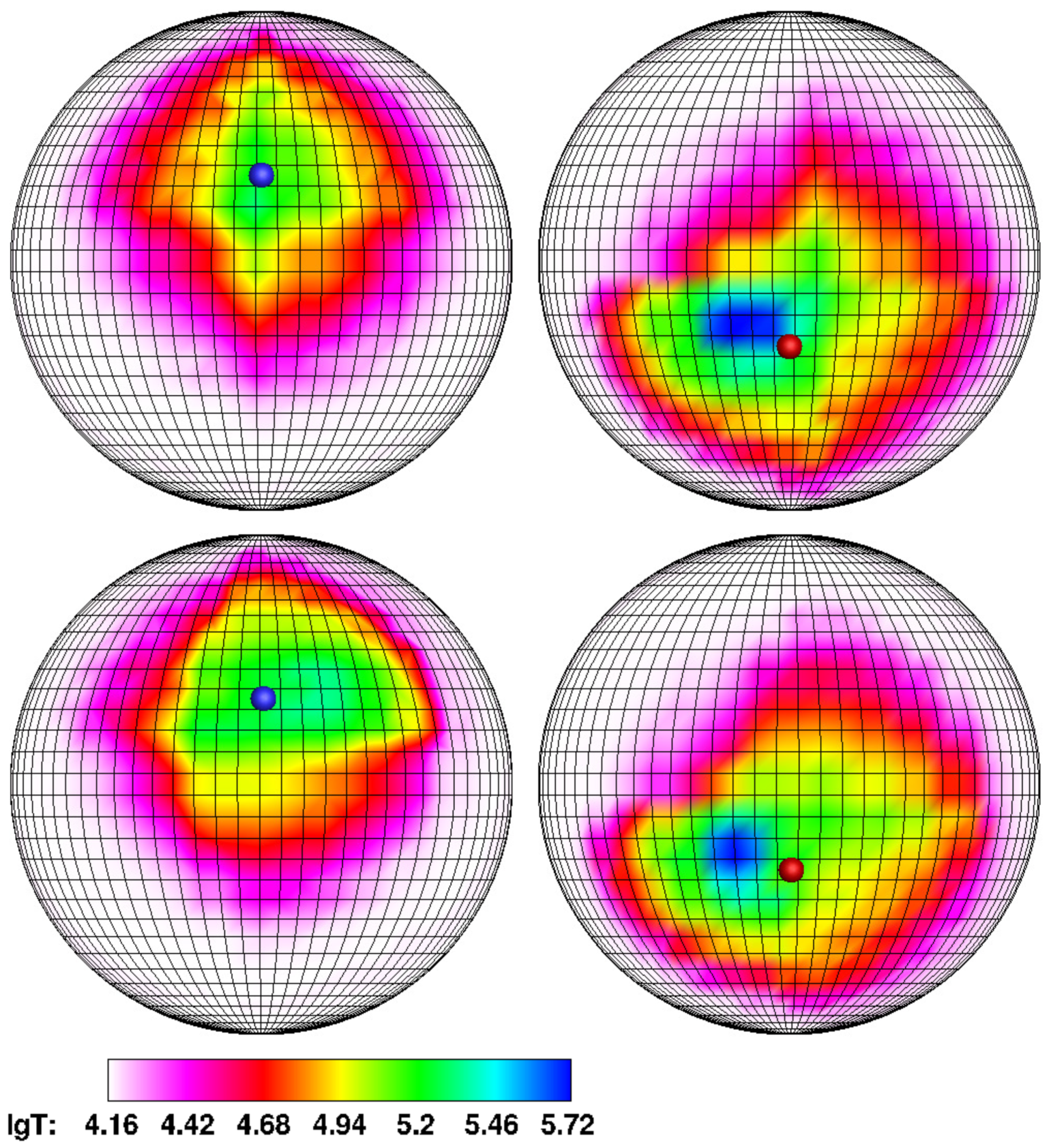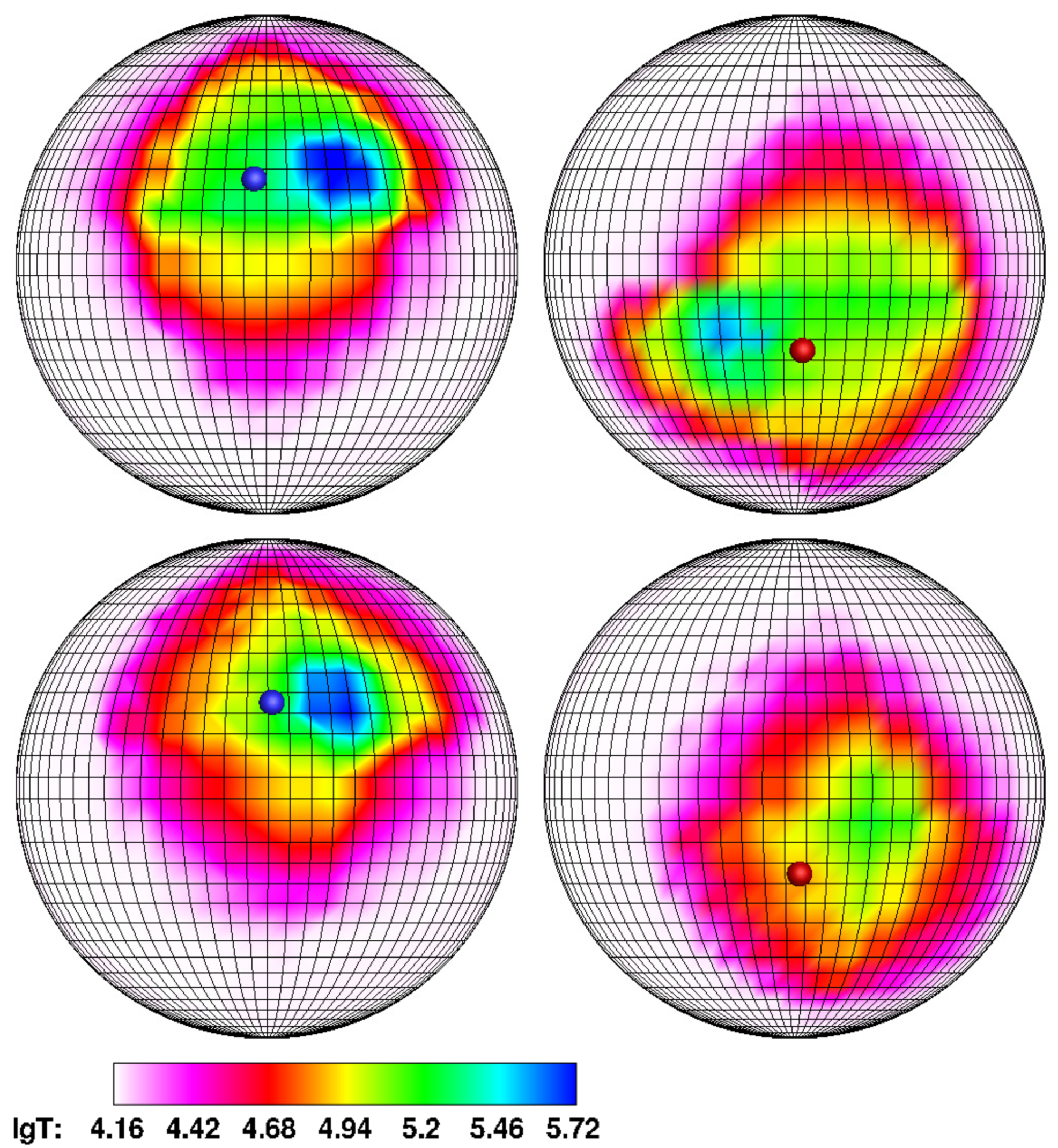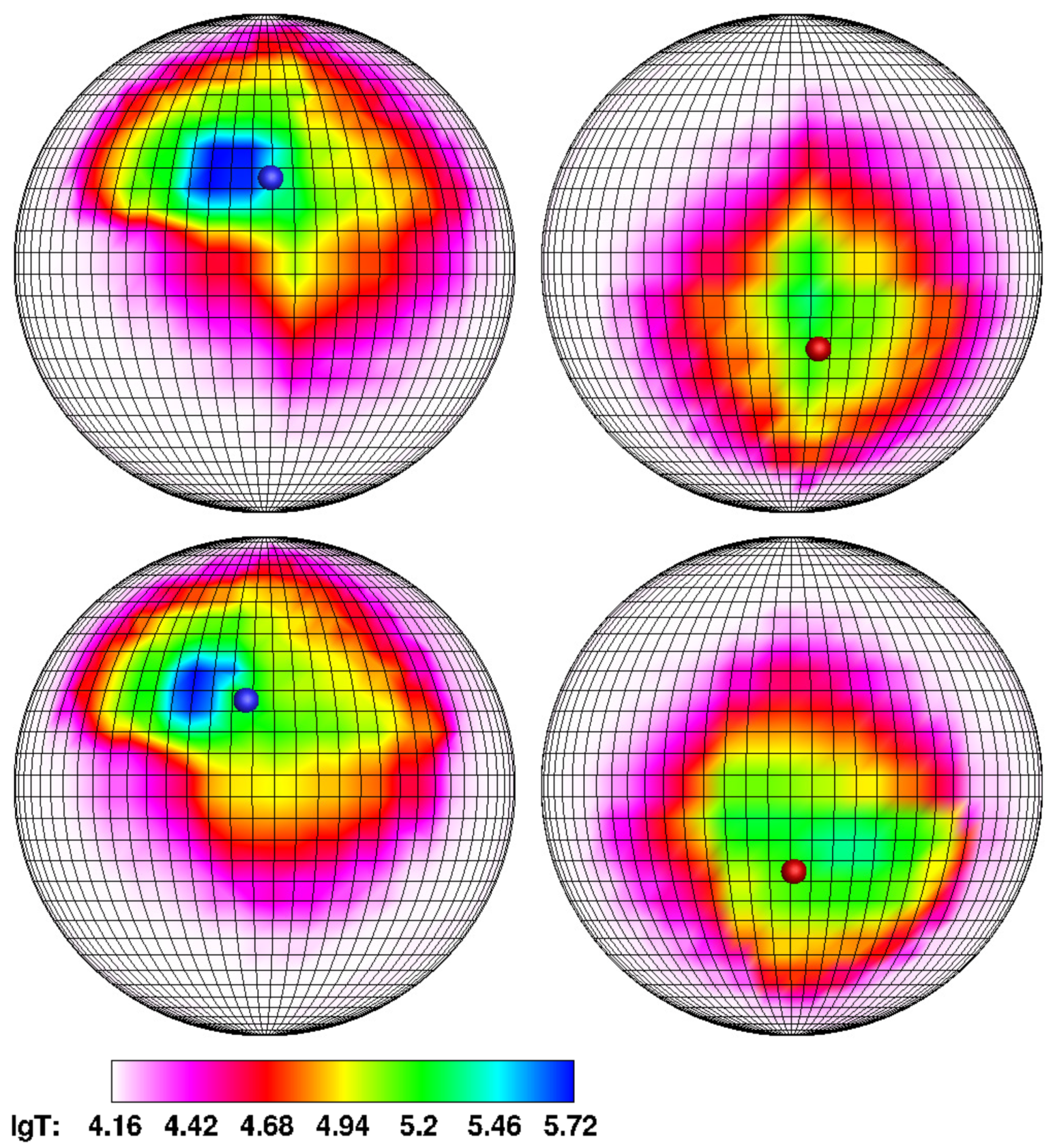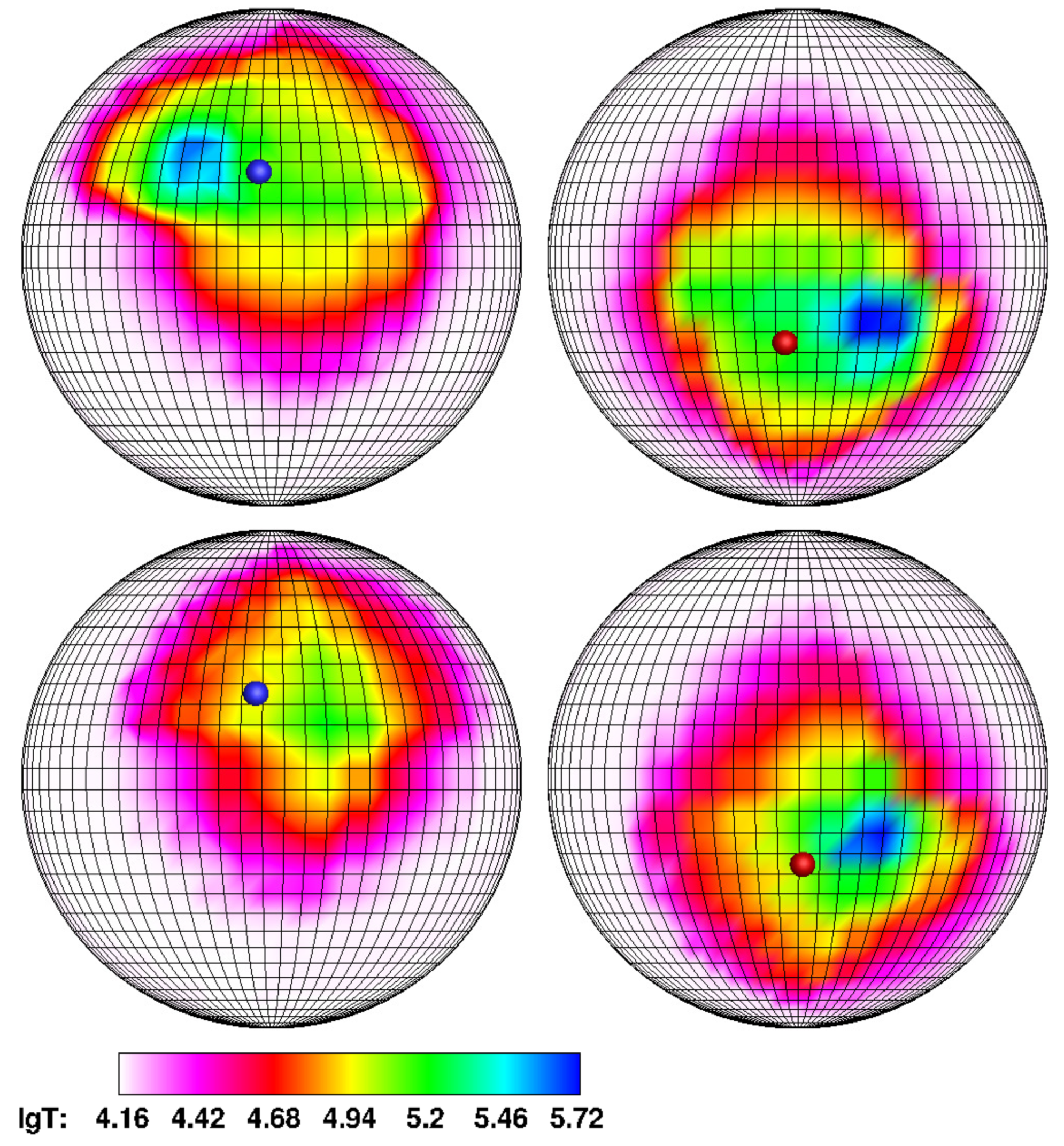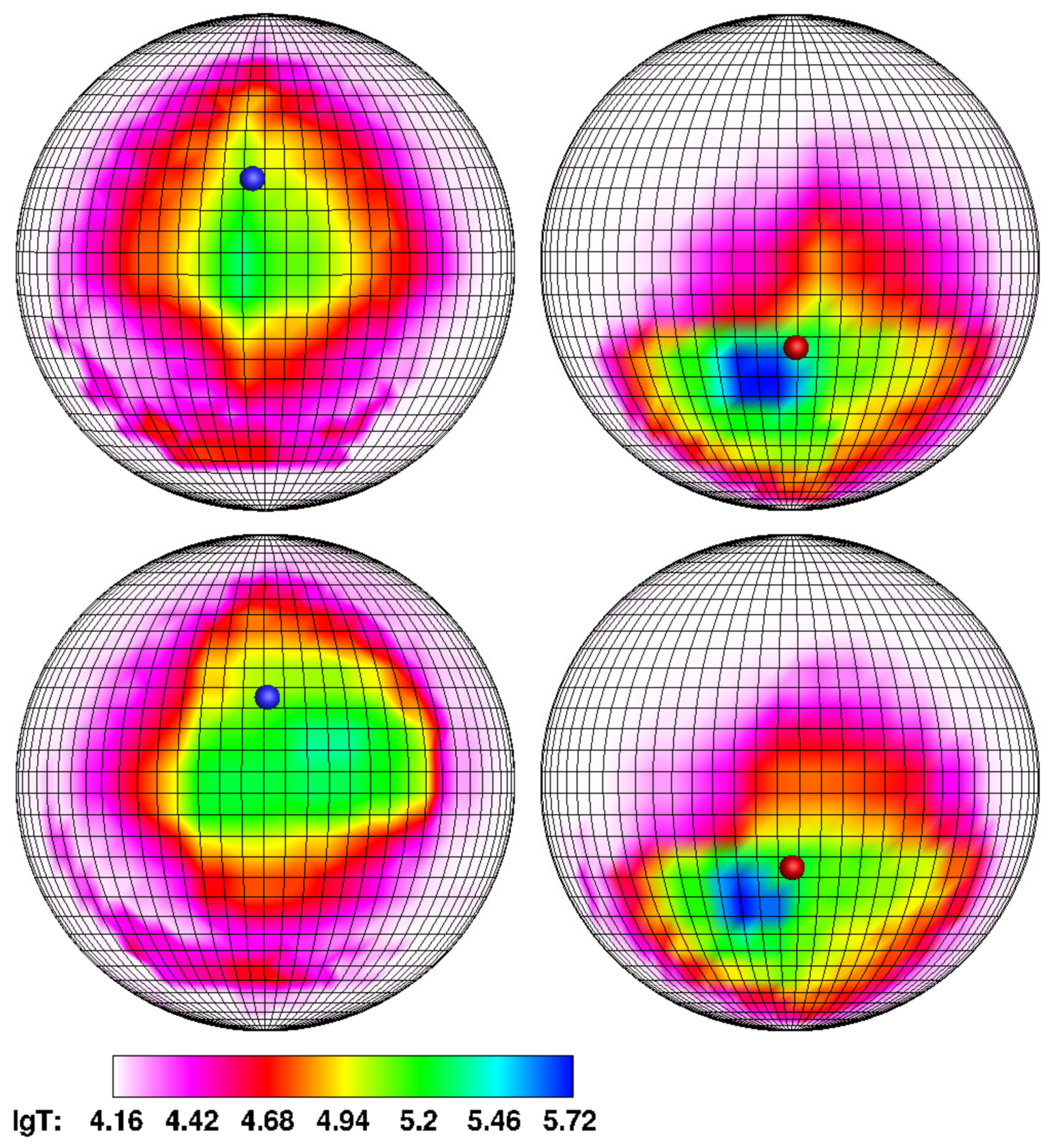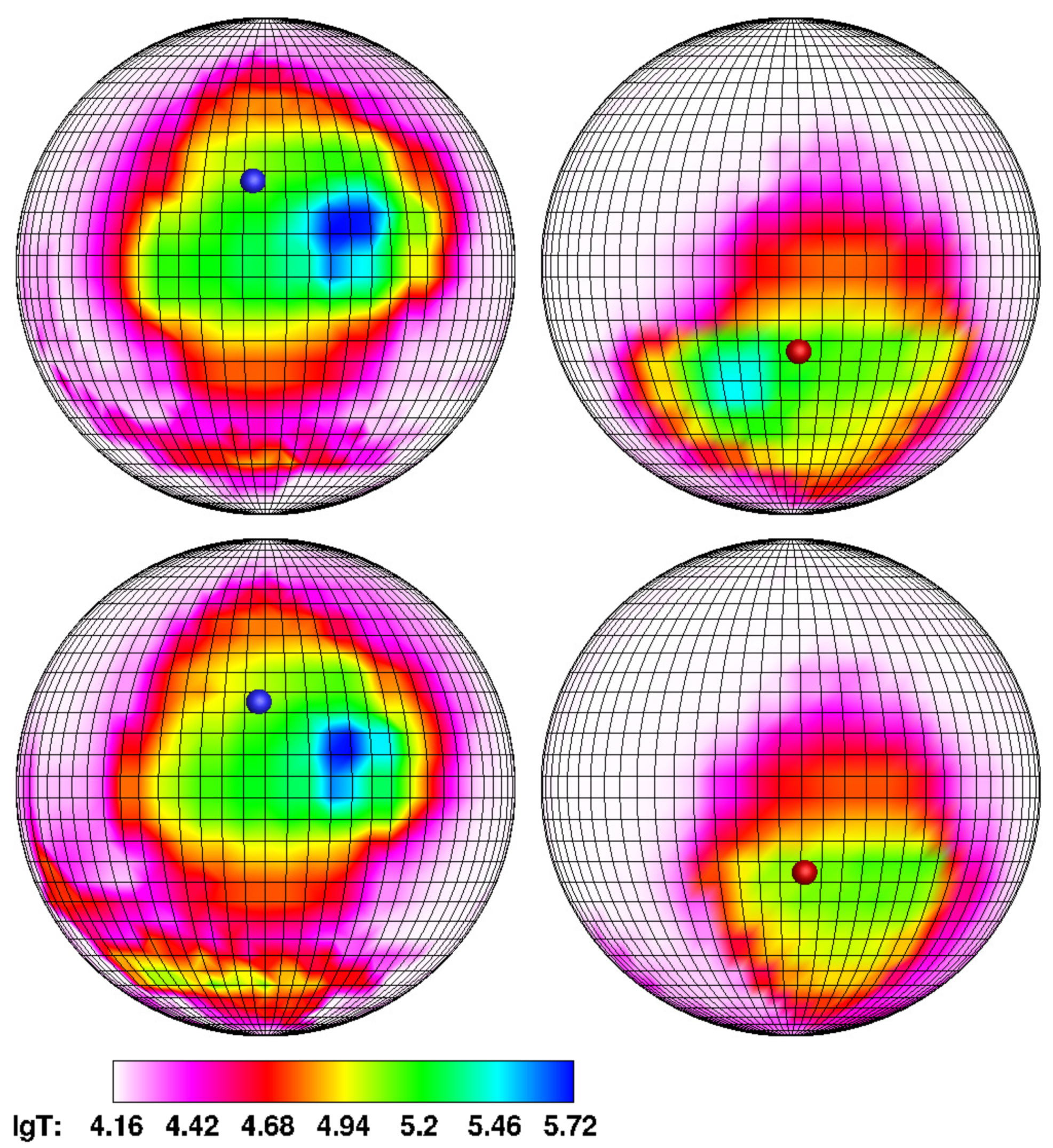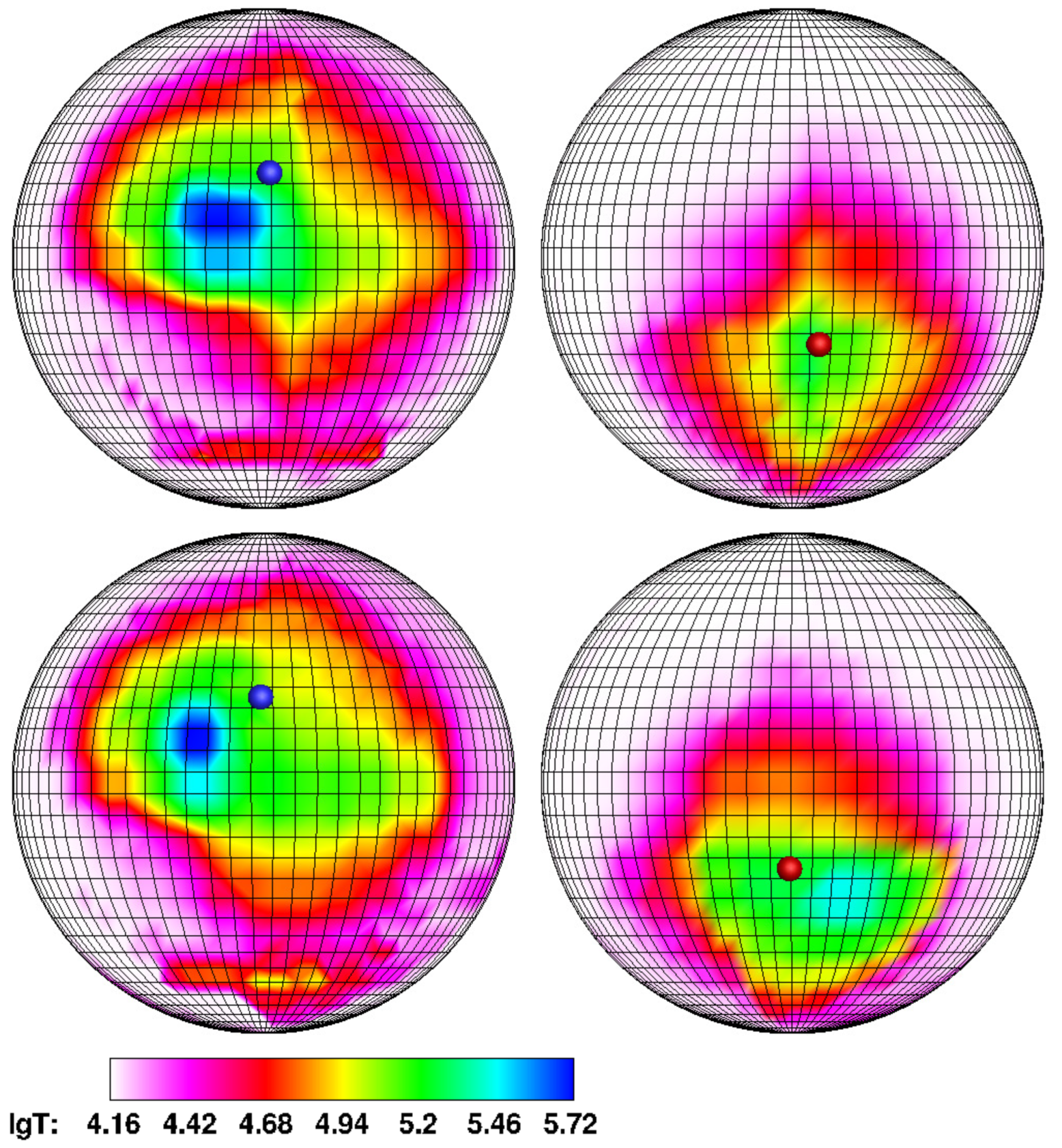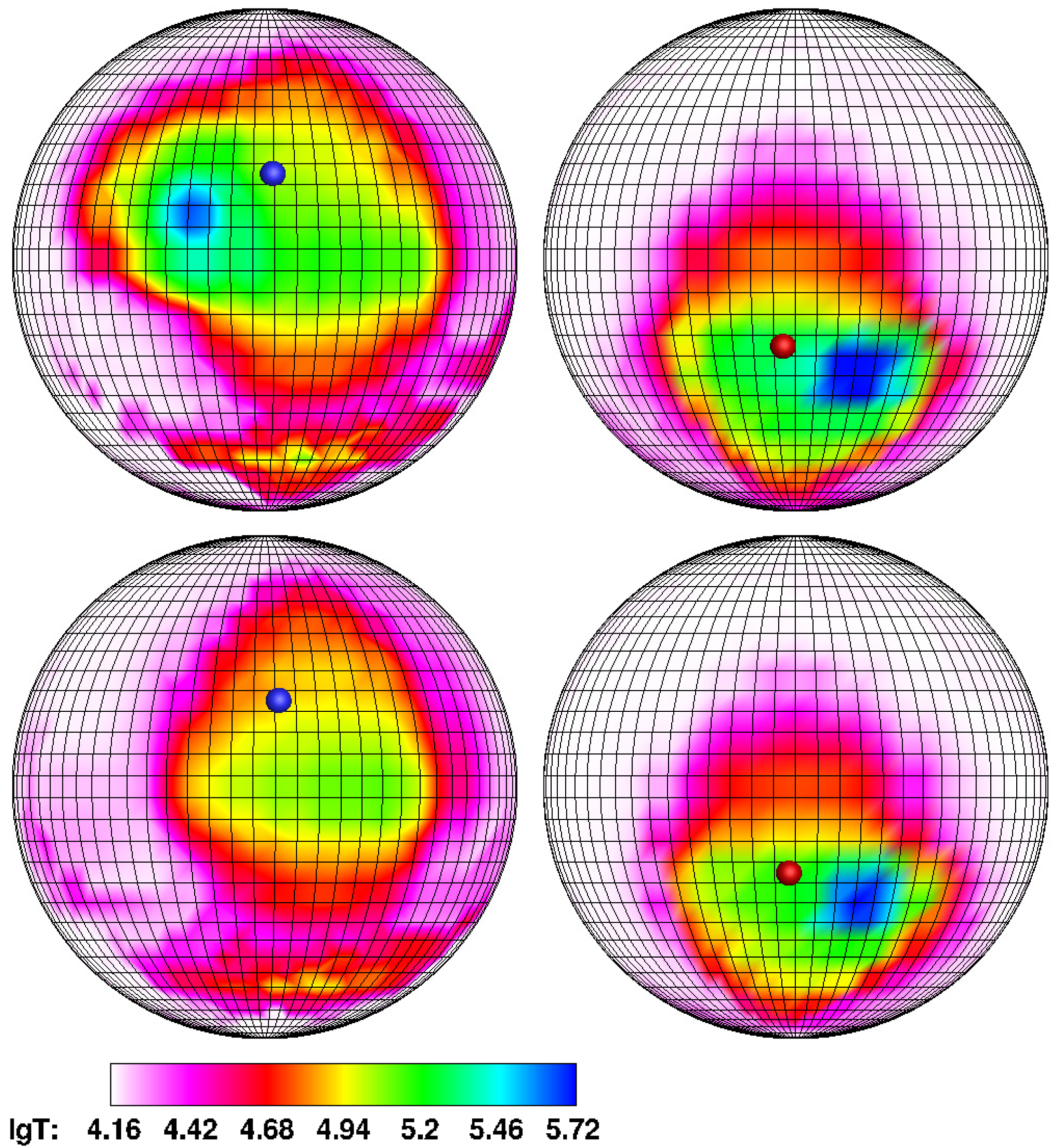3.1. Synchronous Polar
Calculations were performed for the typical synchronous polar V808 Aur, using the stationary model with the following initial parameters [
38,
39,
40,
41,
42,
43,
44,
45,
46,
47,
48] (see
Table 1):
Four variants (models) of calculations of the flow structure are performed, which differ in values of the mass transfer rate. This parameter is set to: Model 1—, Model 2—, Model 3— and Model 4—. It is assumed that Model 1 and Model 2 correspond to the high, Model 3 to the middle, and Model 4 to the low states of the polar.
The results of the three-dimensional numerical calculations for the synchronous system are presented in
Figure 2 and
Figure 3. The figures show the iso-surfaces of the density logarithm in units of the density value at the Lagrange point
. It should be taken into account that when constructing each panel, an individual density scale is used relative to a given value
since
depends on the mass transfer rate.
In
Figure 2, numerical solutions for Model 1 and Model 2 are presented. The figure shows that the changes in the flow structure are insignificant for both models. The density of the jet matter near the Lagrange point
differs by an order of magnitude, but remains quite high: for Model 1,
, and for Model 2,
. This leads to the fact that almost to the accretor itself, the jet matter moves along the ballistic trajectory. At the same time, a noticeable separation of matter by density is observed in the flow structure. The densest layers deviate more strongly from the direction of the primary component, including by the action of the Coriolis force, while the movement of layers with lower density is controlled mainly by the magnetic field of the accretor. It is obvious that for this flow configuration, the accretion of the densest layers should occur at some distance from the magnetic pole, which is observed in the presented solutions (see also
Figure 4).
A further decrease in the mass transfer rate and the density
changes the ratio of the ballistic and magnetic parts of the trajectory by an order of magnitude. In Model 3 (
Figure 3, upper panel), for which
, these parts become approximately equal. The magnetic field of the star much more strongly deflects the motion of the jet and directs it closer to the magnetic pole (see also
Figure 5). The jet matter in its motion rises above the equatorial plane of the polar and moves along the magnetic force lines.
In the low state of the system (
Figure 3, lower panel, Model 4), the density of the jet near the Lagrange point
. In this model, we can see all the structures marked in Model 3. Here, the ballistic part of the jet is practically absent. The matter is almost immediately captured up by the magnetic field and is carried along its lines to the magnetic pole of the accretor. It is also possible to observe an increase in the flow of matter to the both magnetic poles from a common envelope of the binary system.
Note that in the presented calculations, the accretion of jet matter occurs only at one pole. The fact is that in the accepted configuration, this magnetic pole is located opposite the donor, so the matter, having barely left the vicinity of inner Lagrange point , rushes immediately to it. As follows from the analysis of the full picture of the flow, accretion to the second pole (at the level of a few percent of the total mass transfer rate) comes from the common envelope of the binary system. As we assume, the formation of a common envelope can occur as follows. In our numerical model, there is a boundary condition—the density at the border of computational domain, which is small, but not equal to zero. It is based on the fact that even in polars, there is some rarefied matter between components in the system. This matter could be considered a common envelope in the binary system. Its formation enables two mechanisms: due to part of the stream from the inner Lagrange point , which does not include the main mass transfer flow, but dissipates in the system, and due to accreting of the matter flowing from the outer point under the action of dissipative processes.
In
Figure 4 and
Figure 5, the calculated temperature distributions over the accretor surface for the same models as in
Figure 2 and
Figure 3 are presented. For clarity, a grid with a step in longitude and latitude of
is applied to the surface of the accretor. The left hemisphere of each panel contains a white dwarf hemisphere with a north magnetic pole facing the donor. The opposite hemisphere of the white dwarf, containing the south magnetic pole, is represented on the right panel. Positions of the north and south magnetic poles are marked with blue and red symbols, respectively. On the logarithmic temperature scale shown at the bottom of figures, the white color corresponds to the effective temperature of white dwarf
, and blue one corresponds to the temperature of the hot spot (of the order
).
The figures show that the energy release zones are concentrated near the north (main zone) and south (secondary zone) magnetic poles. Its intensity is different: the northern zone, corresponding to the accretion of matter from the jet, has a temperature about five times higher than the southern one, and this ratio is maintained when the mass transfer rate changes. It is also obvious that a decrease in the accretion rate leads to a narrowing of the areas of elevated temperature and a corresponding decrease in the area of the hot spot.
The position of hot spots is determined by the nature of accretion. Thus, the location of the southern hot spot does not depend on the accretion rate since it is formed by incident matter from the common envelope, not by the matter flow of the donor.
The location of the northern hot spot, on the contrary, significantly depends on the accretion rate. With an increase in the mass transfer rate
, the jet density grows, and the flow, due to the action of inertia forces, is shifted to a greater extent in the direction opposite to the orbital rotation of the accretor. It leads, as discussed above, to a shift of the hot spot from the magnetic pole to the right in longitude and down in latitude. So, for Model 1 (
Figure 4, upper panel), we can conclude that the hot spot is shifted in longitude relative to the north magnetic pole by about
. The latitude offset in this case is
–
. In Model 2 (
Figure 4, lower panel), the offset in longitude decreases to
, while the value of the latitude of the hot spot practically does not change, but the area of the energy release zone is reduced by two times. In the middle state of the polar (Model 3,
Figure 5, upper panel), the northern spot, while maintaining its geometric dimensions, is closely approaching the magnetic pole. At the same time, its shifts in longitude and latitude are
. In the low state (Model 4,
Figure 5, lower panel), the northern region of energy release practically coincides with the northern magnetic pole; its area is decreased by four times compared to Model 1.
3.2. Asynchronous Polar
In addition to change in the mass transfer rate, another reason for the movement of hot spots is a variation in the configuration of the accretor magnetic field. A similar phenomenon can be observed in asynchronous polars. Due to alteration in the position of the magnetic dipole axis over time, and hence, the magnetic poles relative to the donor, in these objects, there is a sequential switching of field lines along which the jet matter accretes to the primary component. On time scale of the spin-orbital period in such a binary system, four accretion stages are distinguished. The first two of them are associated with the fallout of jet matter on one of the magnetic poles. Changing the position of the pole is a slow process (the characteristic lifetime of each configuration is about 40 orbital periods of the system; such a value is calculated by Formula (
1) and the initial data), which allows us to consider the solution stationary at every moment of time and use the results of the calculations obtained for the synchronous polar to describe the drift of the hot spot (see
Section 3.1). The motion of the hot spot caused by the pole shift and the corresponding change in the magnetic part of trajectory can be described analytically.
The other two stages of accretion are the processes of switching the jet between the magnetic poles [
49,
50]. In this case, there is a change in the ballistic part of the jet caused by variations in the accretion rate on both spots and in the magnetic configuration, which together lead to a complex picture of hot spots movement. In this section, we analyze the calculation results of the jet switching processes between magnetic poles in the asynchronous polar for various initial configurations of the magnetic field. It is assumed that the accretor has a dipole field configuration, but the dipole axis can be shifted relative to the center of the white dwarf.
The calculations are performed using the non-stationary [
49] model for the typical asynchronous polar CD Ind with the following initial parameters [
51,
52,
53,
54,
55,
56,
57,
58,
59,
60,
61,
62,
63] (see
Table 2).
In our paper, we consider two models of the asynchronous polar CD Ind based on its observational data.
The first model corresponds to the really observed system and, according to observer’s estimates, there is a configuration of a magnetic field with an offset dipole in it. The magnitude of this displacement is half of the radius of the accretor beneath the orbital plane. In this case, we understand that the real magnetic field could be more complex, but as it is obvious for observers, the real field can be described by some effective model of an offset dipole.
In the second model, when considering the same polar, we artificially move the axis of the magnetic dipole so that it passes through the center of the accretor. Thus, we obtain the configuration of the field with a non-offset dipole. This model is used as a comparison with the synchronous polar considered in
Section 3.1 since by the same central position of the magnetic axis in these polars, there are different mechanisms that impact the movement of the hot spots. So, if in the synchronous polar, as we have seen, the drift of hot spots is determined by a change in the mass transfer rate, then in the asynchronous polar, this is caused by a change in the position of the magnetic axis in time during asynchronous rotation of the accretor.
The rate of mass transfer in both models is assumed to be unchanged and equal to .
The results of three-dimensional numerical calculations for the variant with the non-offset dipole corresponding to switching of the flow from the south magnetic pole to the north one are presented in
Figure 6 and
Figure 7. The graphical symbols used here are the same as in
Figure 2 and
Figure 3. The figures illustrate four phases of the switching process: Phase 1 is the beginning of switching (
Figure 6, upper panel), Phase 2 is the formation moment of the arc of matter in the accretor magnetosphere (
Figure 6, lower panel), Phase 3 is the moment of maximum mutual convergence of hot spots (
Figure 7, upper panel) and Phase 4 is the switching completion (
Figure 7, lower panel). On all four panels, the binary system is represented for the position of the observer at the orbital phase 0.9.
The beginning of the switching (
Figure 6, upper panel) coincides with the 1st orbital period from zero phase of the beat period and is characterized by the accretion of the jet just to the south magnetic pole. In the flow structure, it can be seen that the ballistic part of the trajectory for a given mass transfer rate has a longer length than the magnetic one. This flow configuration is similar to the jet geometry for the synchronous polar in a high state (see
Figure 2); however, for the asynchronous polar in the middle state, this similarity is determined by the fact that the axis of the magnetic dipole is perpendicular to the line connecting the donor and accretor centers.
The stage of formation of an arc of matter in the magnetosphere (
Figure 6, lower panel) corresponds to the 5th orbital period and is characterized by two features in the flow structure. First, an accretion of matter occurs at both magnetic poles, and the flow density at a given time to the north pole is an order of magnitude less than to the south. Secondly, the separation of the initially single jet into two streams leads to the formation of the arch of matter at the boundary of the magnetosphere of the white dwarf. Compared with a single-pole accretion (
Figure 6, upper panel), when a split flow is formed, the jet trajectory changes. The length of its ballistic part decreases to the upper boundary of the magnetosphere and then the matter continues to flow along the magnetic field lines: less dense layers accrete in vicinity of the north magnetic pole, and denser layers retain the accretion mode to the south pole.
With the orbital rotation of the polar, the size of the arc of matter in the magnetosphere undergoes changes. At the 9th orbital period, its outer radius still coincides with the boundary of the magnetosphere, and the inner one decreases, which leads to mutual convergence of the hot spots (
Figure 7, upper panel). Obviously, in this case, we should expect the maximum deviation of spots from the magnetic poles. An increase in the volume of the arch indicates that there is an accumulation of matter in it. This, in turn, should be accompanied by an increase in the density of matter in the jet and a short-term decrease in the accretion rate to both poles.
Upon completion of the switching (
Figure 7, lower panel), which occurs at the 13th orbital period, the ballistic part of the jet is significantly reduced, and the flow configuration is an analogy of the picture for the synchronous polar at low state (see
Figure 3, lower panel). At this point of time, the north magnetic pole of the accretor is opposite the donor, and on the magnetic part of the trajectory, the jet matter rises slightly above the orbital plane of the polar, following the magnetic lines to the pole. As it can be seen from the figure, there is practically no deviation of the accretion region from the magnetic pole.
In
Figure 8 and
Figure 9, the iso-surfaces of the density logarithm for the calculation variant with the non-offset dipole corresponding to the switching of the flow from the north magnetic pole to the south are shown. For clarity, the flow structure in the binary system is shown from the point of view of an Earth observer at the orbital phase 0.4.
As can be seen from the figure, the same elements are observed in the flow structure in the previous switching. As the corresponding phases of the switching processes, that are shown in
Figure 6,
Figure 7,
Figure 8 and
Figure 9, coincide in time, we should expect similarity in the flow geometry. Indeed, the passage of the dipole axis through the center of the accretor should lead to equal induction values of both magnetic poles, and hence, to symmetry in the flow structure. The differences when switching the flow from the north magnetic pole to the south consist only in changing the orientation of the dipole axis and the corresponding change in the plane of matter motion in the magnetosphere. However, the physical parameters of the accretion zones and the flow itself near the accretor surface may differ, due to the orbital rotation of the polar. In particular, the Coriolis force should lead to differentiation of the values of the individual accretion rates to the northern and southern hot spots since in this case, one of the magnetic poles turns out to be somewhat closer to the Lagrange point
than the other in terms of the length of the jet trajectory.
Below in
Table 3, the calculated values of the individual accretion rates for switching flow from the south magnetic pole to the north one are given, and in
Table 4, for switching flow from the north pole to the south one. For the notation of values in the tables, as before,
is the density of matter at the Lagrange point
;
is the individual accretion rate for the northern hot spot;
is individual accretion rate for the southern hot spot;
is the total accretion rate to both spots at a given value of the mass transfer rate
. For Phase 1 and Phase 4, the inverse value is indicated in parentheses in the last column in order to compare both switches.
An analysis of the data presented in the tables shows that both switching processes differ primarily in the ratio of individual accretion rates (the last column). The most significant difference is observed at the initial stage of switching (Phase 1): for the switching from south pole to the north one, this ratio is seven times lower than for reverse switching. This value is determined by the smaller, by an order of magnitude, accretion of matter from the common envelope in the first case, while the accretion of matter from the jet to the active pole is approximately comparable in both cases. When an arch is formed in the magnetosphere and its volume increases (Phase 2 and Phase 3), the ratio of the accretion rates to both spots has insignificant differences. At the end of the switching (Phase 4), the ratio of the accretion rates differs by 3.5 times, which is again associated with a drop in the accretion of matter from the common envelope at the second switching.
It can be seen from the figures that the displacement of the dipole practically does not affect the flow geometry. The position of the ballistic part of the jet trajectory remains unchanged compared to the configuration of the non-offset dipole. On the magnetic part of the trajectory, the plane of flow motion has a greater inclination in accordance with the magnitude of the dipole axis displacement. In addition, in the accretion structure, it can be observed the accumulation of matter on the surface of the white dwarf in the plane of the magnetic equator. This element is determined by action of a magnetic trap effect. Due to the fact that the magnetic field strength on the lower side of the accretor is higher than in the upper one, a part of the accreting matter is pushed into the region of the magnetic equator due to the energy loss. Making damped oscillations between two magnetic poles, this matter stops in the specified area. On the upper side of the accretor, the magnetic field of the same intensity is “hidden” inside the star, so there is no accumulation of matter at the equator here.
In order to compare the accretion parameters with the variant of the non-offset dipole, we also construct the corresponding tables for the case of the offset dipole. In
Table 5, the characteristics for the flow switching from the south magnetic pole to the north one are shown, and in
Table 6, those for the switching from the north pole to the south one are presented.
It can be seen from the tables that the dipole displacement leads to different behavior of the total accretion rate for both switching processes. When the jet closes to the north magnetic pole in the first process, a sharp increase in the accretion rate is observed in Phase 4. This indicates the effect of matter accumulation in the jet during the formation of an arch in the magnetosphere of the white dwarf and its subsequent discharge to the magnetic pole. In addition, due to the shift of the dipole axis, the north pole is closer to the Lagrange point than the south one, which also contributes to a local increase in the accretion rate. When switching back from the north pole to the south one, the accretion rate experiences a slight drop, and the process of changing the magnetic poles proceeds smoothly. In this case, despite the fact that the field strength in the vicinity of the south pole is higher than the north one, the south pole is removed from the inner Lagrange point at a greater distance and is weaker from the point of view of accretion. If we compare the tempo values for the south pole in the first switch in Phase 1 and in the second switch in Phase 4, they turn out to be approximately equal. For the north pole in Phase 1, the accretion rate is initially slightly higher than for the south one, and after the first switching in Phase 4, when the matter is discharged to this pole, the high velocity value is maintained for several orbital periods, while the pole is in the vicinity of the inner Lagrange point. It is worth noting that the accretion rate of matter from the polar common envelope does not undergo significant changes and is in the range (4–8) for both poles.
As it was noted above, this variant of the binary system is most interesting for comparison with the synchronous polar. The figures show that the deviation values of hot spots from the magnetic poles, determined by the processes of switching the flow between the poles and by the changing in the mass transfer rate, are comparable. However, the position of the spots in the asynchronous polar has a number of features. At the switching from the south pole to the north one in Phase 1 (
Figure 14, upper panel), the hot spot is adjacent to the pole, which is observed in the flow pattern (
Figure 6, upper panel) but it is elongated in longitude and has a maximum area. For the synchronous polar in the middle state (
Figure 5, upper panel), i.e., at the same mass transfer rate, a similar spot is half as small. This indicates that with a fixed mutual arrangement of the donor and accretor in the synchronous system, the accretion zone tends to concentrate in a small area, whereas with asynchronous rotation and the placement of the magnetic pole close to the equator of the primary component, the hot spot is distributed along the longitude in accordance with the density of the flow in the jet.
At the formation moment of the arc of matter (
Figure 14, lower panel), the deviation of both spots from the magnetic poles does not exceed
. At the same time, the area of the southern spot decreases by two times, and the temperature of the northern spot increases slightly and at this stage is still comparable to the surrounding area. The last circumstance is caused by the fact that although the density of the northern stream is approaching the southern one, the speed of this stream is relatively low at this stage.
The switching Phase 3 (
Figure 15, upper panel) illustrates the moment of maximum convergence of hot spots. The deviation angle of both spots from the magnetic poles is increased and is approximately
. It is worth noting that theoretically, in this case, the flows of matter to both poles should be approximately equal, and the spots should have a comparable temperature. However, as follows from
Table 5, third line, this equality is not fulfilled: the accretion rates differ by 1.7 times at this phase, and the corresponding temperature map shows that the southern hot spot is noticeably weaker than the northern one. From
Figure 7, upper panel, we can conclude that this is due to the orbital rotation of the polar. As a result of the approach of the north magnetic pole to the Lagrange point
and the removal of the south pole from it, the ballistic part of the jet trajectory is somewhat reduced, and the most matter accretes mainly to the northern spot.
Upon completion of the switching (
Figure 15, lower panel), the jet matter falls only in the vicinity of the north magnetic pole, while the area of the hot spot decreases slightly, as well as its temperature. The deviation value of the hot spot from the magnetic pole is also reduced, which now amounts to
. When comparing the accretion rates to the southern spot before the pole switching and to the northern spot after its completion (see
Table 4, Phase 1 and Phase 4), it can be concluded that in the last case, the tempo is decreased slightly. A similar pattern is observed with reverse switching (see
Table 5, Phase 1 and Phase 4): the accretion rate to the southern spot is 20% higher than to the northern one. This is probably due to a partial loss of the flow velocity during the movement of matter in the vicinity of the north magnetic pole. We also note the fact that after the completion of the first switching, the symmetry of the areas of increased temperature relative to the poles changes: now, their center coincides with the center of the hot spot.
When switching the flow from the north magnetic pole to the south one (
Figure 16 and
Figure 17), the changes in the parameters of hot spots and their drift occur, according to the scenario just described.
Note that when the dipole axis deviates from the center of the accretor, the equivalence of the magnetic poles is violated. First of all, this is expressed in the difference in the values of the field strength in the vicinity of each pole. In this case, the accretion rate of the jet matter will depend on two factors: the value of magnetic field induction in vicinity of the pole and the distance from the inner Lagrange point to pole (the orientation of dipole axis relative to this point). Keeping this in mind, the configuration of the offset dipole considered in this paper can be characterized as follows. Since the axis of the dipole is shifted below the center of the white dwarf by half the radius of the star, it is obvious that the north magnetic pole will have a stronger influence on the behavior of the jet than the south one. This is due to the fact that with the proper asynchronous rotation of the accretor, the north pole will pass closer to the inner Lagrange point compared to the south pole. On the other hand, the magnetic field strength near the south pole is noticeably greater than that of the north one. In this regard, when assessing the drift of hot spots, we should expect a smaller deviation of the northern accretion zone, compared to the southern one. However, the constructed temperature maps for the offset dipole indicate the opposite. Thus, when switching the flow from south pole to the north one (
Figure 18 and
Figure 19), it can be seen that at the initial phase of the process, the southern spot is very tightly adjacent to the corresponding pole, and when the energy release zone occurs in the vicinity of the north magnetic pole at the final stages of the process, the latter is as far away from the pole as possible. When the flow is switched back from the north pole to the south one (
Figure 20 and
Figure 21), an observed picture is more consistent with the theoretical reasoning: at the initial stage, the northern spot is located close to the pole, and at the end, the southern spot is removed at a considerable distance from the pole. However, the described location of the spots is in good agreement with the flow geometry shown in
Figure 10,
Figure 11,
Figure 12 and
Figure 13.
At the first switching, due to the considerable length of the ballistic part of the trajectory and taking into account the fact that the axis of the dipole is perpendicular to the line connecting the donor and the accretor centers, the southern spot at the initial moment of time (
Figure 18, upper panel) is located close to the pole, and its center has a deviation of about
. At the same time, at the formation moment of the arch of the matter (
Figure 18, lower panel), the southern spot retains its position, having lost only a little in area, and the weakly pronounced northern spot is already
away from the pole at this stage. Then, at the phase of maximum convergence of hot spots (
Figure 19, upper panel), the angles of their deviation are
for the south and
for the north. Note here that the size of the southern spot still does not change, while the northern spot is slightly elongated along the latitude of the star. Finally, after the switching is completed (
Figure 19, lower panel), the accretion of matter from the common envelope occurs in the vicinity of the south pole, and the northern hot spot has reduced its size by two times in longitude and has retained the magnitude of deviation from the pole.
When switching the flow from the north magnetic pole to the south one (
Figure 20 and
Figure 21), an opposite picture can be observed. At the initial stage (
Figure 20, upper panel), the northern spot is somewhat closer to the pole, but is not located tightly to it, unlike the southern spot at the same phase in the previous switching. Now its deviation is about
and besides, it turns out to be shifted in latitude by an angle of
. At the phase of arch formation (
Figure 20, lower panel), the area of the northern spot is halved, but the position remains unchanged. The southern spot at this time is formed at a distance of
from the pole. The magnitude of spot deviation in longitude from the poles at the stage of maximum convergence (
Figure 21, upper panel) turns out to be approximately equal and amounted to
for each energy release zone. The southern zone is also moved away from the pole in latitude by
. At the final stage of the process (
Figure 21, lower panel), it can be seen that the southern spot retains its size and position relative to the pole, and the accretion region near the north pole, which is currently receiving matter from the polar common envelope, is shifted
further south in latitude.
